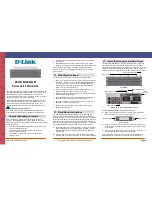
1-12
Configuring RRPP Rings
When configuring an RRPP ring, you must make some configurations on the ports connecting each
node to the RRPP ring before configuring the nodes.
z
RRPP ports, that is, ports connecting devices to an RRPP ring, must be Layer-2 GE ports, Layer-2
XGE ports, or Layer-2 aggregate interfaces and cannot be member ports of any aggregation group,
service loopback group, or smart link group.
z
After configuring a Layer-2 aggregate interface as an RRPP port, you can still assign ports to or
remove ports from the aggregation group corresponding to the interface.
Configuring RRPP Ports
Perform this configuration on each node’s ports intended for accessing RRPP rings.
Follow these steps to configure RRPP ports:
To do…
Use the command…
Remarks
Enter system view
system-view
—
Enter interface view
interface interface-type
interface-number
—
Configure the link type of the
interface as trunk
port link-type trunk
Required
By default, the link type of an
interface is access.
Configure the trunk port carries
the protected VLAN(s)
port trunk permit vlan
{
vlan-id-list
|
all
}
Optional
By default, a trunk port carries
only the default VLAN, which is
VLAN 1 on the switch by
default.
Disable STP
undo stp enable
Required
Enabled by default
Configure the port to trust the
802.1p precedence of the
received packets
qos trust
dot1p
Required
By default, the port priority is
trusted.
Summary of Contents for S5500-SI Series
Page 161: ...3 10 GigabitEthernet1 0 1 2 MANUAL...
Page 220: ...1 7 Clearing ARP entries from the ARP table may cause communication failures...
Page 331: ...1 7 1 1 ms 1 ms 1 ms 1 1 6 1 2 1 ms 1 ms 1 ms 1 1 4 1 3 1 ms 1 ms 1 ms 1 1 2 2 Trace complete...
Page 493: ...2 8...
Page 1111: ...1 10 Installing patches Installation completed and patches will continue to run after reboot...
















































